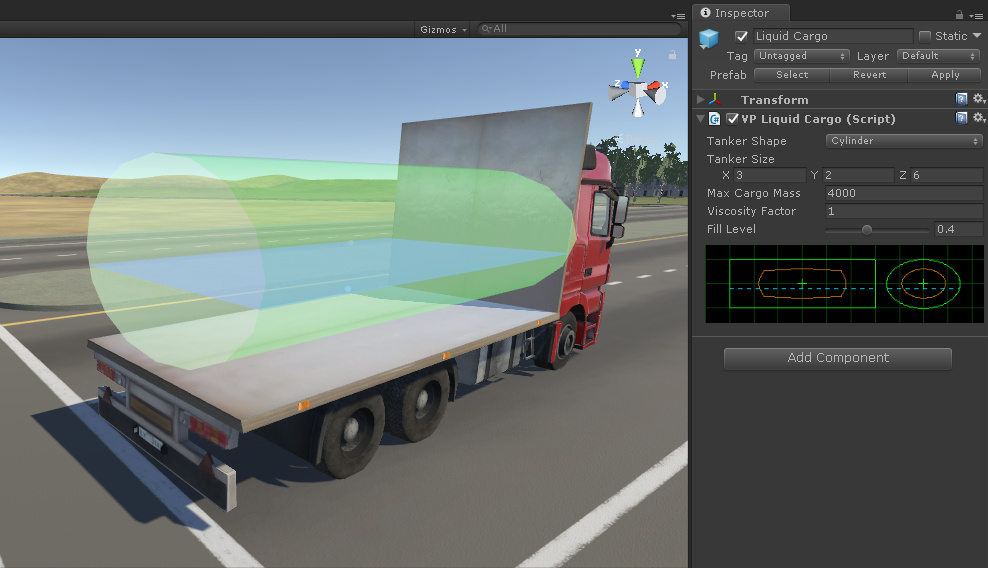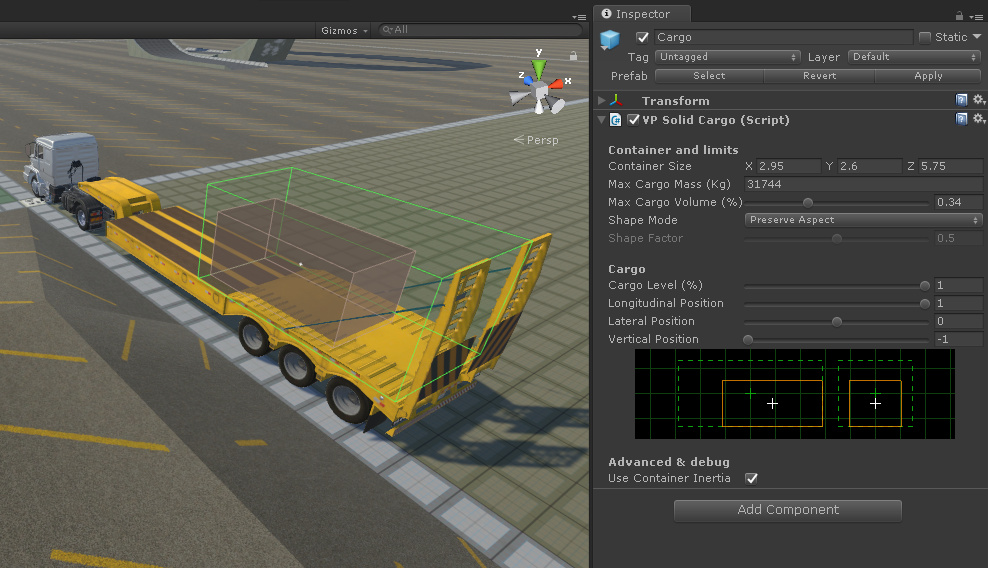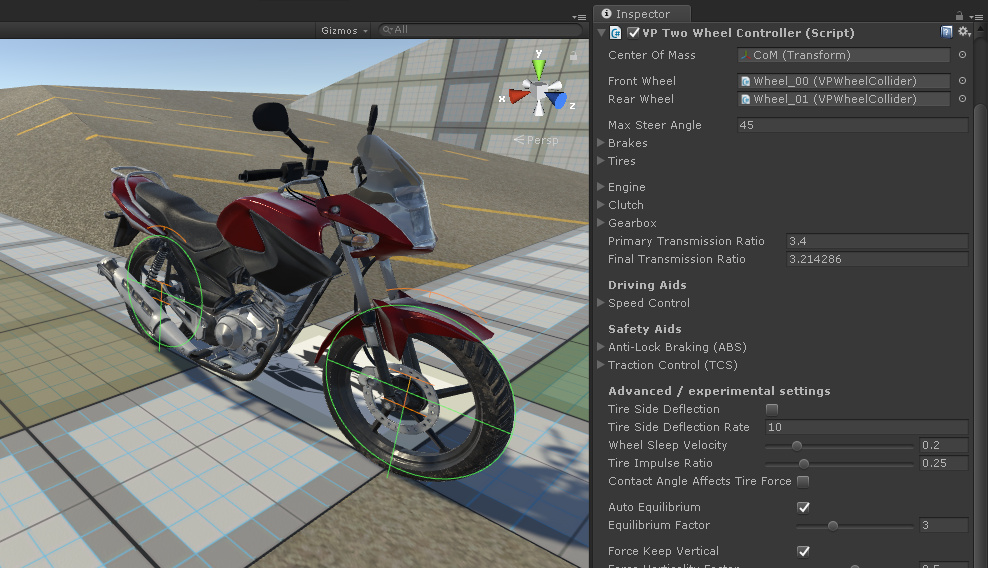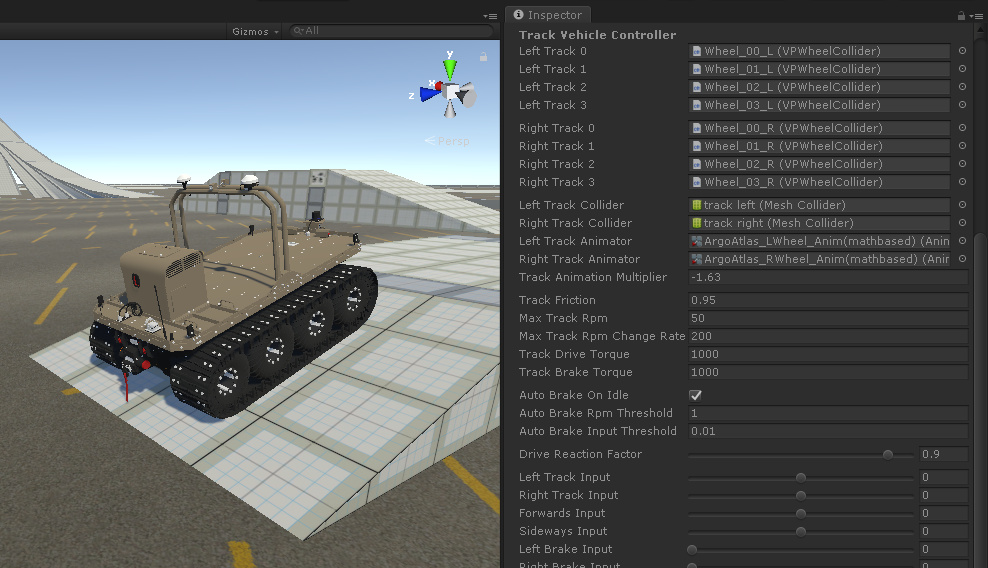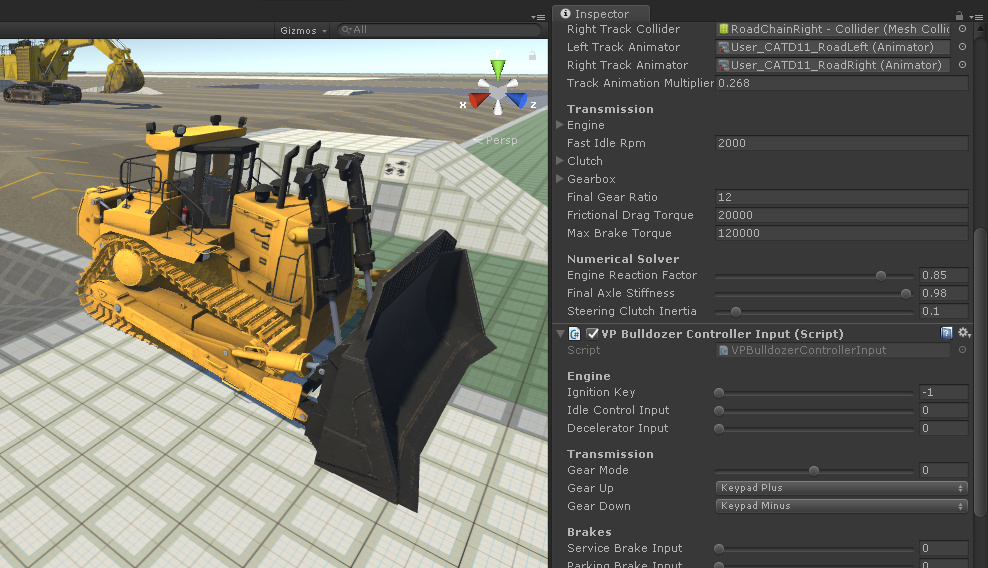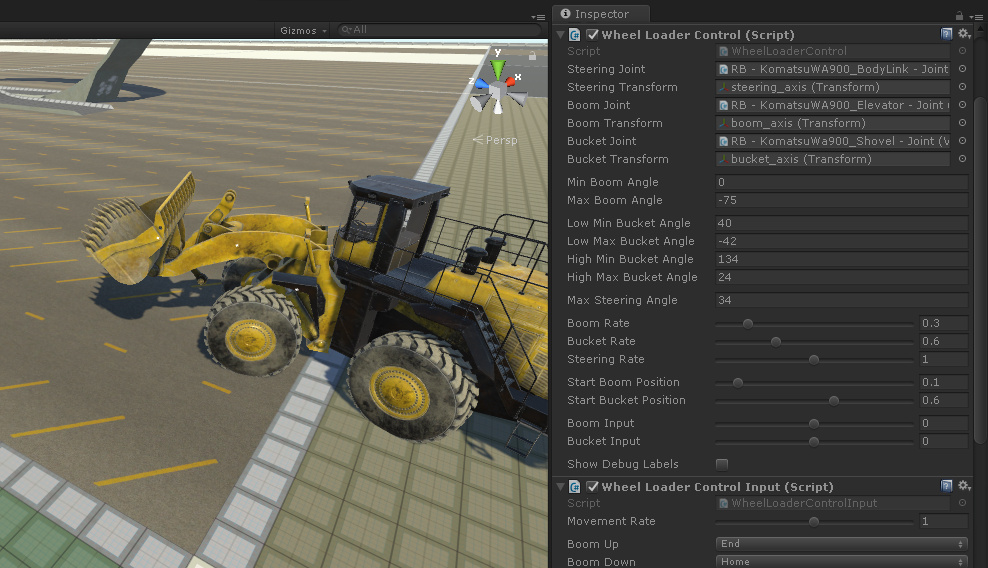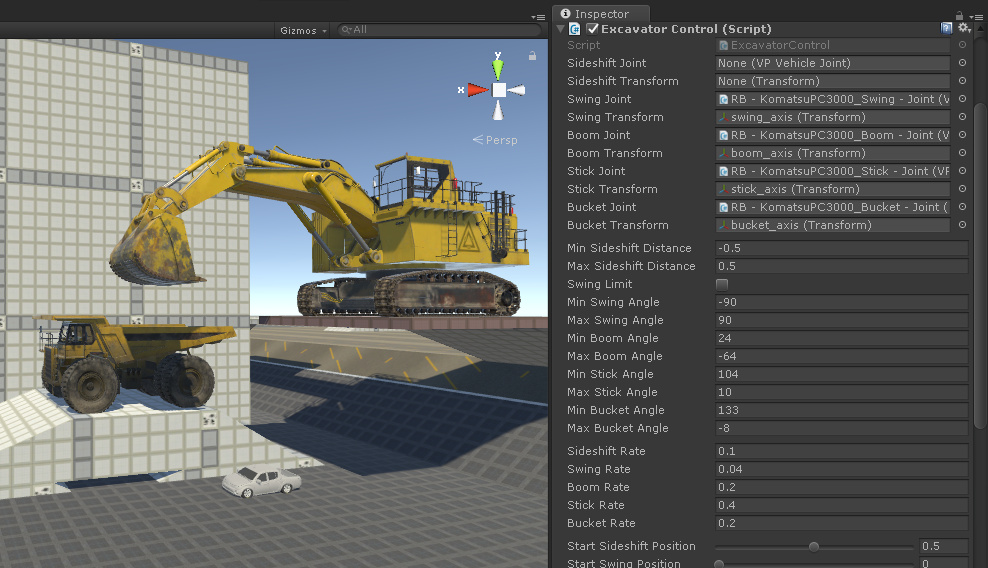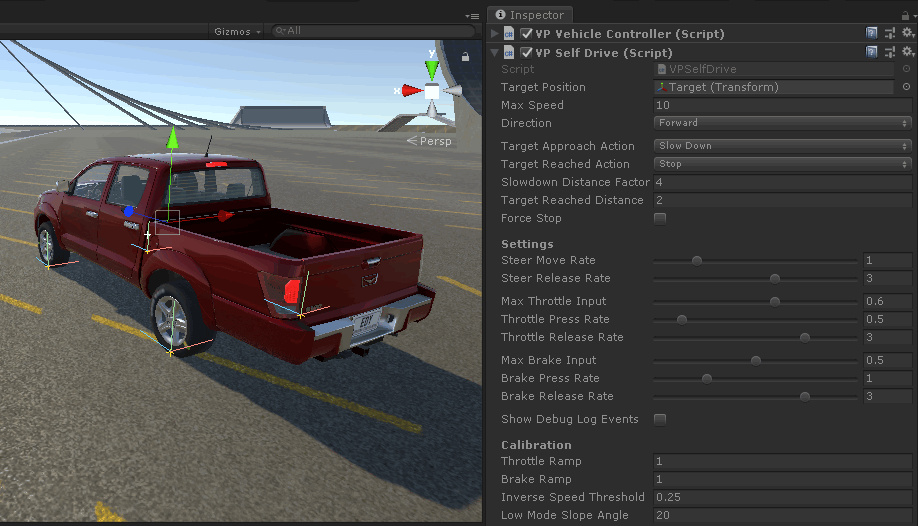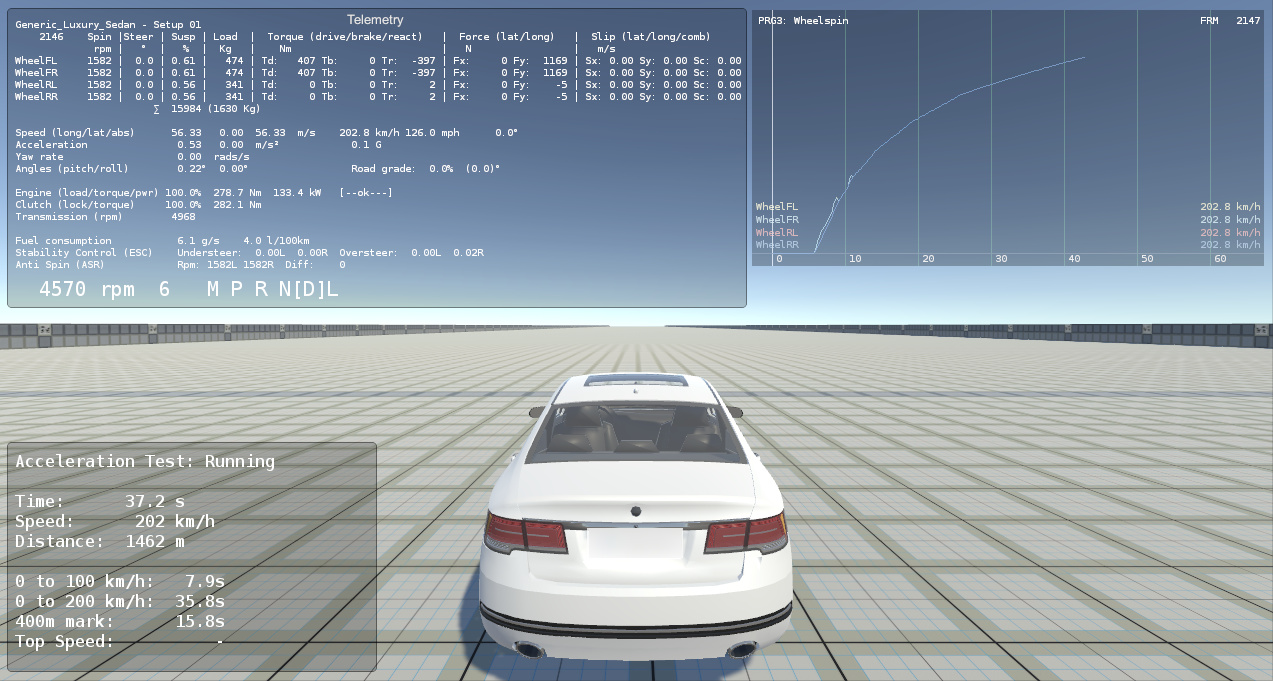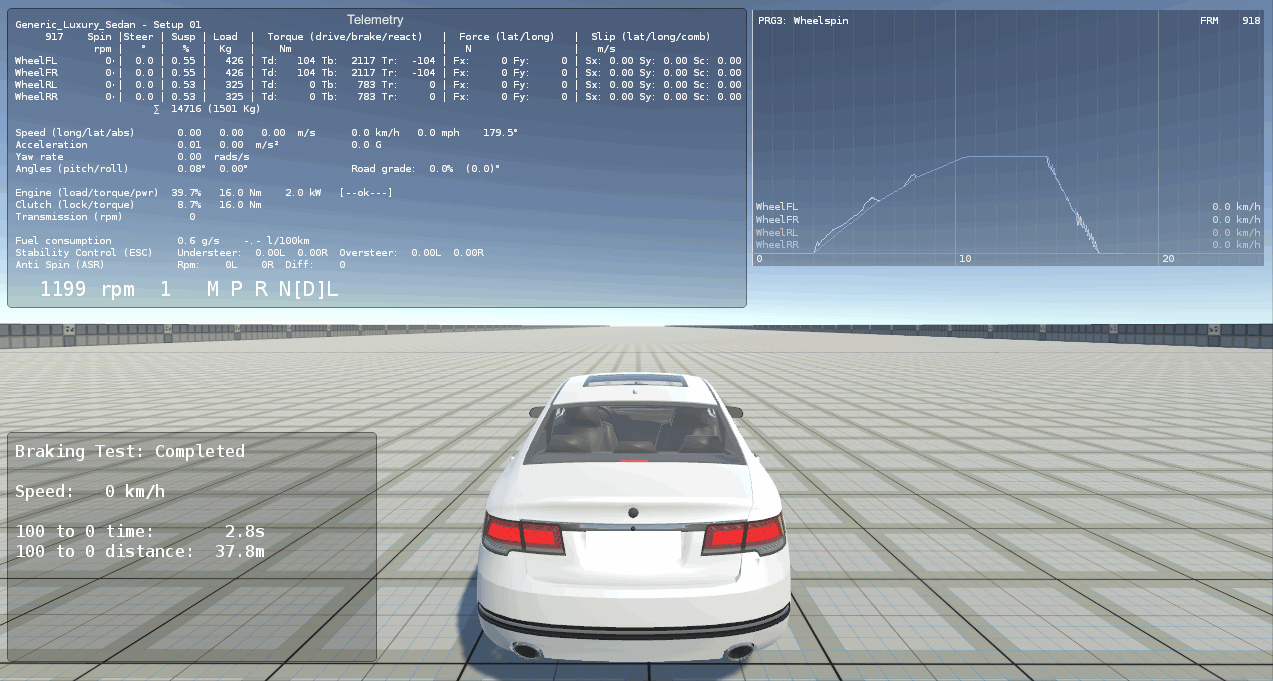Features #
Vehicle Physics Pro is an advanced vehicle simulation kit. Good knowledge of vehicle mechanics, car tuning and real-world set-up techniques is highly recommended. Configuring vehicles in VPP is easy, but setting them up with realistic specifications is almost as difficult as in real vehicles.
If your project requires semi-arcade or gameplay-based vehicle simulation (e.g. as in GTA, Just Cause, Dying Light ...) you may consider Edy's Vehicle Physics instead.
Some features are available in specific VPP editions only. Check out the Licensing section for details.
Vehicle dynamics #
- Engine: torque curve, brake torque, fuel consumption, stall
- Electric motor: torque curve, brake curve, regenerative braking
- Clutch: lock ratio, disc friction, clutch slip
- Torque Converter with locking curve
- AWD (all-wheel-drive), RWD (rear-wheel-drive), FWD (front-wheel-drive)
- Automatic Transmission with P-R-N-D and Manual modes
- Manual Transmission with optional Auto-Shift
- Gearbox: Multiple forward and reverse gear ratios
- Differentials: Open, Locked (spool), LSD (limited slip), Torsen
- Torque Splitter (i.e. Quattro transmissions)
- Brakes: front, rear, neutral, handbrake, retarder
- Steering: Ackerman, TOE, multiple steering axles
- Tire Friction: Flat, Lineal, Smooth, Parametric, Pacejka
- Suspension: spring rate, damper rate, anti-roll bars
- Powertrain efficiency ratio
- Collider-independent vehicle inertia
- Lateral tire deflection
- Wheel rolling friction
- Multi-point aerodynamic drag and downforce
Driving assists #
- Steering assists: auto max grip, auto counter-steer
- Speed Limiter
- Cruise Control
- ABS (Anti-lock Braking System)
- TCS (Traction Control System)
- ESC (Electronic Stability Control)
- ASR (Anti-Spin Regulation)
Extensions #
- Visual effects: steering wheel, lights, dashboard, head motion, blow shadow
- Audio effects: engine, transmission, suspension bumps, tire skid, wind
- Input: Unity standard, wheel devices (DirectInput), XBox gamepad
- Diagnostics: telemetry, graphic telemetry, suspension charts, export data to CSV
- Replay: record, play forwards/backwards, jump to time, flashback, save to file
- Camera controller: first person, attached, follow, orbit, fixed
- Motion platforms: DBox, Simtools, CxC
- Race track utilities: timing, auto-brake zones, limited speed zones
- Vehicle Toolkit component with commonly used tools, procedures and data
- Visual and/or physical damage on impacts
- Procedurally generated speed and rpm gauges
Ground materials #
- Grip and drag per wheel
- Ground marks: skid marks, wheel trails
- Wheel particle effects: smoke, dust
- Rumble effects: step, saw, triangle, perlin
Advanced #
- Electric vehicles, single or multiple motors, regenerative braking
- Advanced suspension dampers: bump/rebound, slow/fast
- Dynamic suspension that automatically preserves the ride height
- Variable-rate suspension springs
- Cargo simulation, solid and liquid
- Articulated and multi-body vehicles
- Tracked vehicles (caterpillars)
- Hydraulic articulations: excavators, stabilizers, cranes, etc
- Two-wheeled vehicles (experimental)
- OBD-II inspired protocol (Data Bus) for communication with vehicles
Automation and autonomous vehicles #
- Robust, highly efficient spline component
- PID-based target chasing
- Waypoint-based autonomous driving
- Framework for automated test (e.g. acceleration time, braking distance)
- Vehicle state snapshot record and restore
Vehicle model #
- Physically accurate vehicle dynamics model
- Each vehicle part (block) is simulated in connection with others
- Physical torque connection between parts, from engine to wheels
- Advanced tire friction model providing static, adherent and sliding forces
-
All expected and unexpected effects are simulated. Examples:
- Driveline windup may be observed in locked differentials as static torques.
- Under certain conditions a drive wheel could rotate backwards in open differentials.
- A stalled engine could be restarted without using the ignition key if the vehicle gains enough speed: Press clutch / Engage gear / Release clutch.
Customization #
- Up to 10 axles (20 wheels) in standard vehicles
- Unlimited wheels per vehicle in custom vehicles
- Custom add-ons for external features (e.g. custom gearbox logic)
- Custom vehicles and configurations (e.g. number and type of motors)
- Custom Blocks or internal vehicle parts (e.g. custom differential type)
- Custom ground materials by overriding the provided ground material manager
- Custom automated tests for measuring vehicle specifications
- Customization examples provided: input logic, custom handling, simple vehicle controllers, turbo charger ...
Performance #
- Mobile and low-end systems supported
- Efficient, scalable design
- Supports physics update rates as low as 16 Hz (0.06 timestep)
- Dynamics Solver exposes substeps per-vehicle for any update rate: 50, 400, 1000, 2000 Hz
Integration #
- Standard Unity components and workflows
- Fully working examples and demo scenes provided
- Unity menu integration (Component > Vehicle Physics)
- Coherent and detailed inspectors
- Well structured and commented C# code
- No external dependencies
- All Unity platforms supported
Support #
- Extensive and detailed online documentation (this site)
- Customer support provided directly from the developer
- Professional Services available on-demand at hourly rates
- Dedicated Support Q&A site
- Updates delivered by GIT repositories and Unitypackages.
- In continuous development since 2010 (changelog)
Application examples #
Most of the 3D models shown here belong to third party customers and are not included in Vehicle Physics Pro.
- Racing games and simulators
- Configure and fine-tune the vehicles applying real-world techniques and tricks.
- Training simulators
- Apply the specifications of real vehicles to Vehicle Physics Pro and build a simulator for training drivers. Example: Truck simulator
- Studying / researching
- Design unbiased experiments by reproducing the same tests under different conditions and configurations. Example: ABS vs. no-ABS test
- Learning and Teaching
- Learn how real vehicles and internal parts work: basics, requirements, behaviors, side-effects, configuration techniques, performance tips...
- Prototyping
- Experiment with any crazy idea you may have: two engines, one per front-rear axle? Sure! Observe the behavior and all the side effects.
Feature examples #
Most of the 3D models shown here belong to third party customers and are not included in Vehicle Physics Pro.
- Multi-body vehicles
-
A vehicle may be composed of several rigidbodies, each one with several wheels attached. Articulations between rigidbodies are implemented with the VPVehicleJoint component.
- Dynamic suspension
-
The suspension of a group of wheels is dynamically adjusted to adapt to the supported weight keeping a constant ride height. Tractor trucks use this kind of suspension implemented as air bags.
Example: when the truck starts in the video below (~sec 30) the rear wheels increase their suspension stiffness to adapt to the trailer's weight.
- Liquid & solid cargo
-
The liquid cargo component simulates a fluid sloshing in a closed tank. The solid cargo component allows to easily simulate a solid cargo: position in the vehicle, volume occupied, weight...
- Specialized vehicle support
-
Special custom vehicle controllers are provided for electric vehicles, two-wheeled vehicles (experimental), tracked vehicles, bulldozer, and diesel-electric vehicles.
- Articulated vehicles support
-
VPP provides add-on components for controlling hydraulic mechanisms such as steering, booms, buckets, etc. found in typical machinery.
Framework for autonomous vehicles #
- Target chasing and autonomous driving
-
VPP provides "Follow target" components that controls throttle, brake and steering for reaching or following a static or moving target within the configured conditions. A robust and highly efficient spline component is also included. Waypoint systems, road lanes, and AI algorithms may be implemented on top of these components.
- Automated test framework
-
A base class VPAutomatedTestBase provides an easy to use API for implementing automated and repeatable tests. Acceleration and braking tests are already provided.
The complete telemetry data of each test may be recorded and exported to CSV for further analysis via VPTelemetryExporter component.
- State snapshots
- The complete state of the vehicle may be recorded, then restored any number of times. This provides the same precise initial conditions in repeatable tests.
